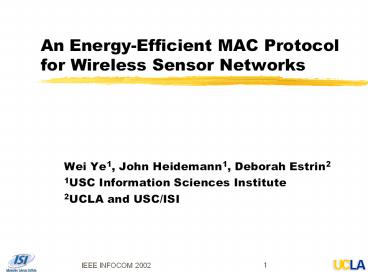An Energy-Efficient MAC Protocol for Wireless Sensor Networks - PowerPoint PPT Presentation
Title:
An Energy-Efficient MAC Protocol for Wireless Sensor Networks
Description:
IEEE INFOCOM 2002. 1. An Energy-Efficient MAC Protocol for Wireless Sensor Networks ... Fragmentation in IEEE 802.11. No indication of entire time other nodes ... – PowerPoint PPT presentation
Number of Views:169
Avg rating:3.0/5.0
Title: An Energy-Efficient MAC Protocol for Wireless Sensor Networks
1
An Energy-Efficient MAC Protocol for Wireless
Sensor Networks
- Wei Ye1, John Heidemann1, Deborah Estrin2
- 1USC Information Sciences Institute
- 2UCLA and USC/ISI
2
Introduction
- Wireless sensor network
- Special ad hoc wireless network
- Large number of nodes w/ sensors actuators
- Battery-powered nodes energy efficiency
- Unplanned deployment self-organization
- Node density topology change robustness
- Sensor-net applications
- Nodes cooperate for a common task
- In-network data processing
3
Medium Access Control in Sensor Nets
- Important attributes of MAC protocols
- Collision avoidance
- Energy efficiency
- Scalability in node density
- Latency
- Fairness
- Throughput
- Bandwidth utilization
4
Energy Efficiency in MAC
- Major sources of energy waste
- Idle listening
- Energy consumption of typical 802.11 WLAN cards
- idlereceive 11.05 to 12 (Stemm 1997)
- Example directed diffusion (Intanagonwiwat 2000)
5
Energy Efficiency in MAC
- Major sources of energy waste (cont.)
- Idle listening
- Long idle time when no sensing event happens
- Collisions
- Control overhead
- Overhearing
- We try to reduce energy consumption from all
above sources - Combine benefits of TDMA contention protocols
6
Sensor-MAC (S-MAC) Design
- Tradeoffs
- Major components in S-MAC
- Periodic listen and sleep
- Collision avoidance
- Overhearing avoidance
- Message passing
7
Periodic Listen and Sleep
- Problem Idle listening consumes significant
energy - Solution Periodic listen and sleep
- Turn off radio when sleeping
- Reduce duty cycle to 10 (200ms on/2s off)
8
Periodic Listen and Sleep
- Schedules can differ
- Prefer neighboring nodes have same schedule
- easy broadcast low control overhead
Border nodes two schedules broadcast twice
9
Periodic Listen and Sleep
- Schedule Synchronization
- Remember neighbors schedules
- to know when to send to them
- Each node broadcasts its schedule every few
periods of sleeping and listening - Re-sync when receiving a schedule update
- Schedule packets also serve as beacons for new
nodes to join a neighborhood
10
Collision Avoidance
- Problem Multiple senders want to talk
- Options Contention vs. TDMA
- Solution Similar to IEEE 802.11 ad hoc mode
(DCF) - Physical and virtual carrier sense
- Randomized backoff time
- RTS/CTS for hidden terminal problem
- RTS/CTS/DATA/ACK sequence
11
Overhearing Avoidance
- Problem Receive packets destined to others
- Solution Sleep when neighbors talk
- Basic idea from PAMAS (Singh, Raghavendra 1998)
- But we only use in-channel signaling
- Who should sleep?
- All immediate neighbors of sender and receiver
- How long to sleep?
- The duration field in each packet informs other
nodes the sleep interval
12
Message Passing
- Problem Sensor net in-network processing
requires entire message - Solution Dont interleave different messages
- Long message is fragmented sent in burst
- RTS/CTS reserve medium for entire message
- Fragment-level error recovery ACK
- extend Tx time and re-transmit immediately
- Other nodes sleep for whole message time
13
Msg Passing vs. 802.11 fragmentation
- S-MAC message passing
- Fragmentation in IEEE 802.11
- No indication of entire time other nodes keep
listening - If ACK is not received, give up Tx fairness
14
Implementation on Testbed Nodes
- Compared MAC modules
- IEEE 802.11-like protocol w/o sleeping
- Message passing with overhearing avoidance
- S-MAC (2 periodic listen/sleep)
15
Experiments
- Topology and measured energy consumption on
source nodes
- Each source node sends 10 messages
- Each message has 400B in 10 fragments
- Measure total energy over time to send all
messages
16
Conclusions
- S-MAC offers significant energy efficiency over
always-listening MAC protocols - Future Plans
- Measurement of throughput and latency
- Throughput reduces due to latency, contention,
control overhead and channel noise - Experiments on large testbeds
- 100 Motes, 30 embedded PCs w/ MoteNIC
- URL http//www.isi.edu/scadds/
Thank You!

